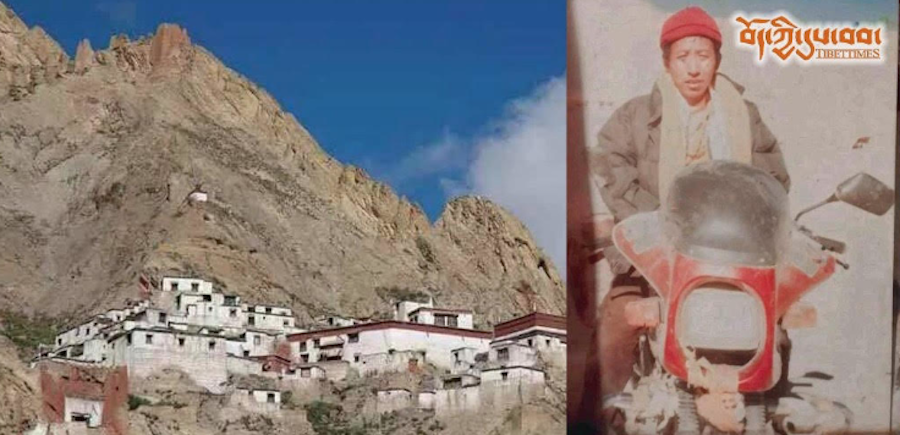 By Olive L. Sullivan
By Olive L. Sullivan
The sound of chanting and soft drumming greeted visitors to the Overman Student Center on the Pittsburg State University campus Tuesday afternoon. Following the sound to the lower level, those visitors would find an unusual sight for southeast Kansas: a group of saffron-clad, shaven-headed Tibetan Buddhist monks performing the opening ceremony to a sacred ritual dating back thousands of years.
The monks, from the Drepung Loseling Monastery in India, are on campus as part of the Performing Arts and Lecture Series, to create a sacred sand painting, or mandala. In Tibetan this art is called dul-tson-kyil-khor, which literally means “mandala of colored powders.”
It will take four days, working from 9 a.m. to 4 p.m., to create the detailed design of the Mitrukpa mandala. The name means “unshakable” in the language of Tibet, according to spokesman Legden. Legden studied with the monks in India for many years, but now acts as their spokesman as they travel around the U.S. and Europe sharing their mystical traditions.
On previous U.S. tours the lamas have displayed this sacred arts in museums across the country, including the Arthur Sackler Gallery, Washington; Field Museum of Natural History, Chicago; Peabody Essex Museum, Salem; the Indianapolis Art Museum, Indianapolis; Kimbell Art Museum, Fort Worth, and The Provincial Museum of Alberta, Edmonton, Canada.
Tuesday, the monks began the sacred painting with a ceremony including chants, songs and music. Next, they began marking out the design on a table surfaced with blackboard. Using a large wooden compass and a weighted string, four monks painstakingly began to draw the design. The finished work will be about five feet by five feet in size.
Once the chalk outline is completed, the monks begin applying the colored sand. A tray of silver bowls stands ready, each bowl filled with a different color of sand. The monks use a tool called a chak-pur, a funnel of brass or silver, which is ridged on one side. It is filled with sand. The monks then rub a metal rod over the ridges, creating a low buzz reminiscent of a room full of bees. The buzzing vibrates the grains of sand to flow like liquid over the surface. Each monk concentrates upon his work, as exacting and delicate as painting. The colors layer upon one another; a pink base takes a design of red and white; across the table, a green base receives a different design, all painted in exquisite detail. Each piece adds up to the sacred whole.
There are 10 monks in the touring group; four work on the mandala at any given time, while the rest wait to fill in when one gets tired. The work looks fatiguing, too. The monks bend from the waist over a waist-high table, supporting their arms on small silken cushions while they work. It takes anywhere from an hour to three hours to get the initial chalk drawing completed. They are supervised in their work by a portrait of the Dalai Lama, their religious leader, set up on a makeshift altar with a brightly colored cloth and an offering of fruits. Legden explained that the mandala itself is a kind of offering; the creation of the complex design is form of meditation and prayer. Buddhists accumulate merit through such offerings, as well as through prayer and chanting.
Legden said the particular mandala the monks are creating in Pittsburg is meant to promote healing and strength in times of disaster or tragedy. Following the terrorist attacks of Sept. 11, 2001, the Dalai Lama suggested this mandala to help build compassionate healing in the United States and the world. There are thousands of different mandalas representing the many deities or “compassionate beings” of Buddhist theology. The basic design of Mitrukpa is over 3,000 years old.
“We hope this one will help,” Legden said. “We will do the same one unless the Dalai Lama requests another one.”
For the Drepun Loseling group, there are three reasons for the Mystical Arts of Tibet tour. The first is contribute to world peace and to begin a discussion of ways to generate love and respect. Legden said the Dalai Lama believes all people should “walk together on a spiritual path.” The tour also helps raise awareness of the tragic situation in Tibet since the Communist Chinese invasion of 1959, when the Dalai Lama and thousands of monks were forced to flee their homes to refuges in India. The original Drepun Loseling Monastery is in Tibet; the one in India is a reproduction of the monks’ original home. Drepung Loseling Monastery was one of Tibet’s largest monastic universities.
Located in the hills on the northern outskirts of Lhasa, it was established in 1416 as an institute of higher Buddhist education. At its zenith Drepung Loseling housed some 10,000 monk students coming from Tibet, China, Himalayan India, Mongolia and eastern Russia.
There is now a third site, the Drepun Loseling Institute, in Atlanta, Ga. The final reason for the tour is to raise money to help the refugees that still stream into the Indian center for help, needing food, clothing, education, health care and more. The main goal, Legden said, is to help maintain Tibetan independence, culture and sacred traditions even in exile.
At the university, visitors came and went throughout Tuesday afternoon. The opening ceremony was packed with onlookers, who examined the merchandise for sale – Tibetan prayer flags, chak-pur, temple bells like tiny cymbals – before drifting off to class or other work. Many of them passed through the room again during the day, checking on the progress. A few stayed, lounging on the sofas or asking questions of those monks not working on the mandala. An atmosphere of respect pervaded the room, a sign that something holy was at work, even if the trapping seemed unfamiliar and exotic to this southeast Kansas audience.
Edie McCracken, director of the Performing Arts and Lecture Series, said that’s exactly what attracted her to the monks when she saw them at a national conference. She even admitted that she could hardly stay away from them Tuesday, popping in and out from her office down the hall to check their progress. She described their visit as “something completely unique and educational.”
McCracken said there are some differences from the regular performance here in Pittsburg. At some locations, the monks also perform sacred dance and music, and often give presentations which talk about the dire situation in Tibet, urging people to help work for their freedom from Chinese rule. Traditionally, the sand mandalas are destroyed shortly after creation as a metaphor for the impermanence of life. During the closing ceremony, the sand is swept up and placed in an urn. To promote global healing, half of the sand is distributed to the audience, while the rest is poured into a nearby body of water. The healing waters then carry the blessing to the ocean, from whence it spreads throughout the globe for planetary healing.
McCracken said the monks will not select a body of water near Pittsburg, instead taking the sand with them to their next performance. She explained, “They prefer a large, flowing body of water.” The local options – University Lake and Cow Creek – didn’t quite fit the bill.
The monks will continue working on the mandala each day from 9 a.m. to 4 p.m. At 4 p.m. on Friday, they will begin the closing ceremony of consecration. The public is invited to visit any time, and to attend the final ceremony. For more information on Tibetan mystical arts, visit the web at www.mysticalartsoftibet.org, or visit the Drepung Loseling Monastery site at www.drepung.org.
Olive L. Sullivan may be reached at (620) 231-2600, Ext. 134, or at olive.sullivan@morningsun.net.









